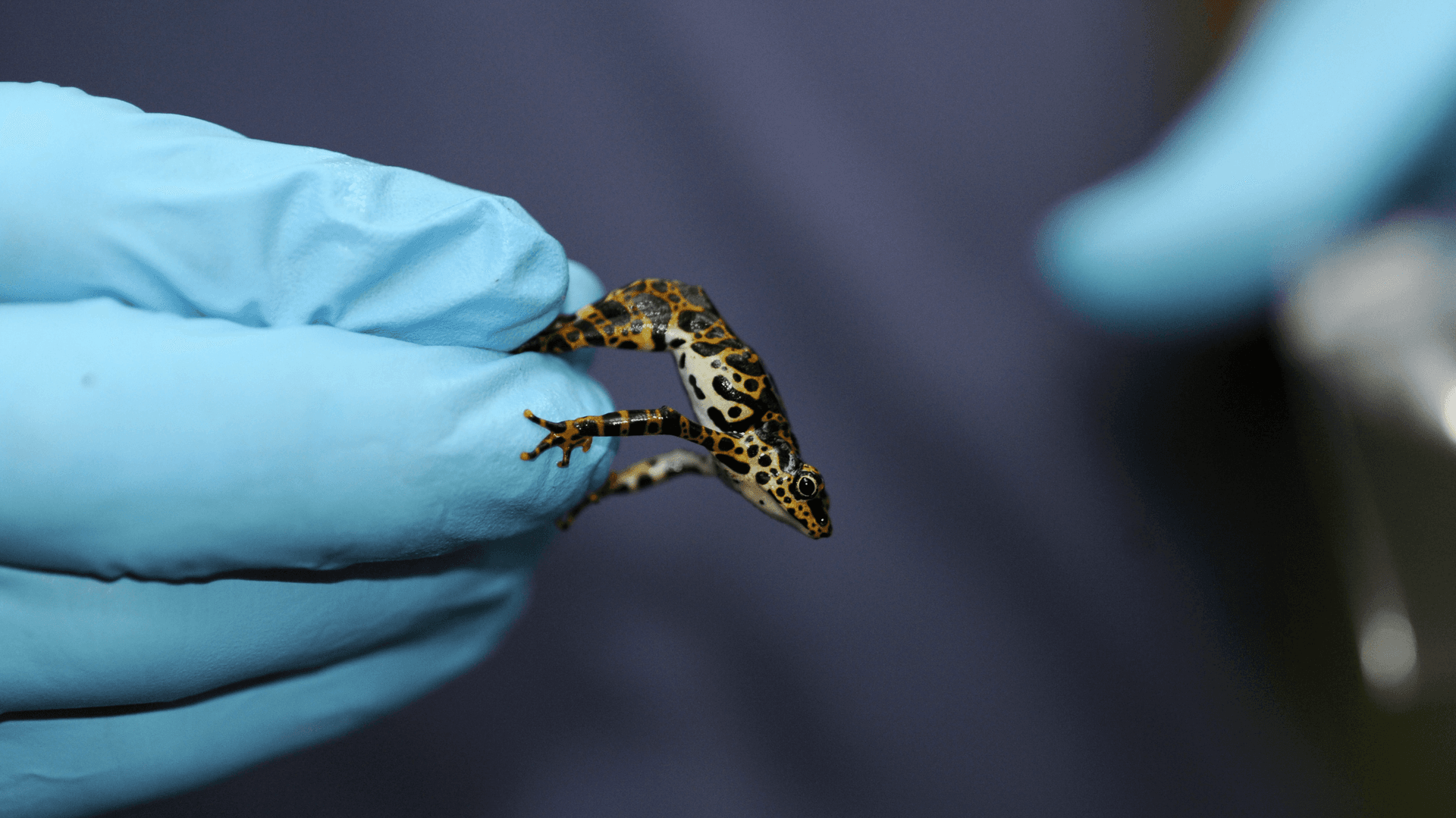‘Good’ bacteria could save amphibians hit by fungal diseases
Biologist Jorge Guerrel puts a tiny Toad Mountain harlequin frog into a plastic bag for weighing and measuring on the slopes of Panama's Cerro Sapo March 26, 2011. The endangered frog is likely to be wiped out in the wild by the imminent arrival of frog chytrid, a fungus that has decimated amphibian species across the globe in recent decades.
Scientists at the University of Massachusetts may have found a tool to combat the fungal diseases that are killing millions of frogs, bats and snakes around the world.
The researchers discovered that beneficial soil bacteria with anti-fungal properties live on some amphibians’ skin, and apparently protect them from acquiring these diseases, says Doug Woodhams, an assistant professor of biology at UMass Boston, who works with amphibians in Panama.
“Many of the bacteria that we can culture from some amphibian species are able to inhibit the fungus in culture,” Woodhams explains. “We also have some population-level data which show that populations [with] these anti-fungal bacteria can persist with ‘Bd’ in the environment and survive.”
Bd is the chytrid fungus that has been spreading around the world, devastating amphibian populations.
Amphibian populations that tend to have more of the beneficial bacteria seem to be surviving, while populations that have fewer individuals with the bacteria seem to disappear, Woodhams says. Woodhams compares these bacteria to the ‘good’ bacteria in the human gut that can prevent people from getting sick.
Some of these bacteria, Pseudomonas, for example, can occur in water and soil, but they can also occur on the amphibian skin and produce antibiotic compounds, Woodhams explains. Other bacteria can produce secondary metabolites, which the bacteria probably use in competition with each other. But they also can be anti-fungal and inhibit the growth of the chytrid fungus.
Even more exciting to Woodhams and his team are bacteria they've found that produce volatile compounds.
“[These are] compounds that are not only soluble through the water, but can be airborne and affect chytrid fungus at a distance,” he explains. “For example, one of the Pseudomonas bacteria produces hydrogen cyanide, which is anti-fungal and can kill other organisms, as well.”
Another bacterium, Rhodococcus, which may inhibit white-nose syndrome in bats, was also found on amphibian skin, so Woodhams and his team decided to test it against Bd. It, too, turns out to be anti-fungal and can kill Bd on amphibians.
These are important first steps, but it may be only a matter of time before a newly emerging chytrid fungus — a variant called Bsal, which primarily affects salamanders — arrives in the US,, Woodhams warns. The danger is that once Bsal hits the US, it will have a similarly devastating effect, because the salamander population will have no immunity from the disease.
“That’s why there is a recent increase in the concern and the research activity trying to figure out which amphibians, which salamanders — even frogs — may be susceptible,” Woodhams says. “Especially in the Appalachians, which is the world's hotspot of salamander biodiversity. We really want to keep this new salamander chytrid out, and if we can’t, then we need some tools — for example, probiotics or anti-fungal treatments that may be able to help.”
Right now the research is still focused on amphibians in a captive setting, Woodhams says. Treating wild populations is more difficult and scientists need much more information to determine whether it could be effective and safe.
“One of things I try to emphasize in the work that I'm doing: I would never want to introduce a new bacterium or a new potential pathogen to an area where it didn't exist before,” Woodhams says. “We want to prevent novel introductions of species. So we're working on finding beneficial bacteria that already exist in populations and either augmenting those populations on susceptible frogs and salamanders or adding it to the habitat where it's already found.”
This article is based on an interview that aired on PRI’s Living on Earth with Steve Curwood.
The World is an independent newsroom. We’re not funded by billionaires; instead, we rely on readers and listeners like you. As a listener, you’re a crucial part of our team and our global community. Your support is vital to running our nonprofit newsroom, and we can’t do this work without you. Will you support The World with a gift today? Donations made between now and Dec. 31 will be matched 1:1. Thanks for investing in our work!
